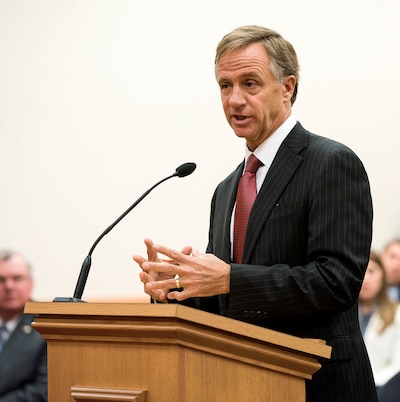It’s official: three of Tennessee’s four urban school districts are suing the state for more money.
Last week, Metropolitan Nashville Public Schools became the latest district taking the state to court, following on the heels of litigation already in process by school systems in Memphis and Chattanooga. The districts’ situations differ enough to justify separate suits, but the underlying message is the same: local school leaders believe Tennessee isn’t providing enough money to properly educate students.
Their crusades may be successful, based on the track record of similar cases across the country. And national school funding experts also side with the districts. They say Tennessee’s funding formula is badly in need of updates.
Similar lawsuits have been filed in 45 of 50 states. The cases started cropping up after 1973, when the U.S. Supreme Court ruled in San Antonio Independent School District v. Rodriguez that education is not a federal right, and therefore school funding is entirely a state matter. From then on, if school leaders believed their state legislature wasn’t giving them enough money to educate students properly, they could go to their state courts as a recourse.
About 60 percent of school funding cases have gone to trial, and states have lost the vast majority of those, says Michael Rebell, an attorney who has represented districts in New York State in funding cases.
“In almost every state constitution, there’s an explicit cause that guarantees students some kind of an adequate education … so you have a very strong legal anchor to begin with,” Rebell said. “And when you give evidence of what’s going on in schools, particularly in underfunded areas, judges tend to be shocked at conditions in these schools.”
Most cases thrown out were due to a judge who said school funding was not under the court’s purview and should be handled by the legislative and executive branches. That’s an argument Tennessee Rep. Bill Dunn made during the most recent legislative session when he unsuccessfully lobbied for a constitutional amendment barring courts from interfering in schools.
The separation-of-powers argument hasn’t held much water in Tennessee, though. State courts heard three historic school funding cases from the late 1980s to the early 2000s, siding with local districts every time. Those cases keyed in on built-in inequities in the state’s funding formula that cause some districts to get more money than others.
New focus
The latest round of lawsuits, while all different, zoom in on inadequacy and argue that Tennessee is not funding its schools based on the true cost of educating today’s students.
The move from a focus on equity to adequacy is a trend nationwide, abetted by the move toward more rigorous academic standards, Rebell said. Districts are no longer as focused on whether they are getting more or less than other districts, but if they are getting enough money to help their students meet standards — in other words, to provide kids with an adequate education.
“Every school should have enough resources to meet adequacy, however we define it,” he said.
And when it comes to providing adequate funding to educate students based on today’s standards, national experts say Tennessee isn’t.
Tennessee uses a complex formula known as the Basic Education Program, or BEP, to generate and distribute state education dollars to public schools to provide a basic level of education. But critics charge that the formula, developed more than a quarter century ago in response to one funding lawsuit against the state, falls short on two fronts: 1) it doesn’t properly account for the cost of educating students in the 21st century; and 2) Tennessee doesn’t spend enough money on schools, period.
Tennessee has made historical increases in education spending under Gov. Bill Haslam. Still, in a time of economic surplus, it lags behind other states in school spending.
"Tennessee is really at the bottom of the national barrel in terms of how much funding it provides to support public education."
David Sciarra, Education Law Center
“Tennessee is really at the bottom of the national barrel in terms of how much funding it provides to support public education,” said David Sciarra, executive director of the Education Law Center, a group advocating for fair and equitable school funding.
But state officials argue otherwise. This summer, the state released a 25-page defense of its funding formula in response to the lawsuit filed last year by Shelby County Schools in Memphis. Haslam has maintained all along that the state is filling its constitutional duty to its public school students. And the State Department of Education, in its statement about Nashville’s lawsuit, noted that education spending has increased steadily during the last few years.
Time to reset
Experts say Tennessee is overdue for a reset. They say the state should step back and look at what it costs to educate kids today, taking into account how technology, demographics and school accountability have changed since the BEP was approved in 1992. (The legislature included some updates to the formula this year, while leaving out others.)
“One of the things the legislature could embark on (would be) a cost study to figure out what kind of formula would serve Tennessee schools today given the demands lawmakers are placing on schools and students for performance,” Sciarra said.
Tennessee’s formula also should take into account the high concentration of impoverished students served by many of its districts, say advocates for equitable funding. The state already gives districts more money per low-income student. But when low-income students are segregated in schools, the impact of poverty magnifies, says Rebecca Sibilia, CEO of EdBuild, another nonprofit organization focused on fair school funding.

“This is where your students are much more likely to encounter violence on their way to or from school, they are much more likely to only have one parent at home, be faced with lower (living conditions),” she said. “When you start to fund for concentrations for students with higher needs, you can actually start to address some of those larger societal needs.”
Sibilia points to California as a school funding success story. The state recently overhauled its spending formula — and ramped up education spending.
But it’s rare to see states start over. “Comprehensive overhauls don’t happen that often,” she said. “The fact that they don’t is indicative of how very political the discussion is.”
Sciarra says that’s where the courts come in.
“The reason you see litigation is not because people want to go to court,” he said. “It’s because the other branches of government aren’t doing their job.”


